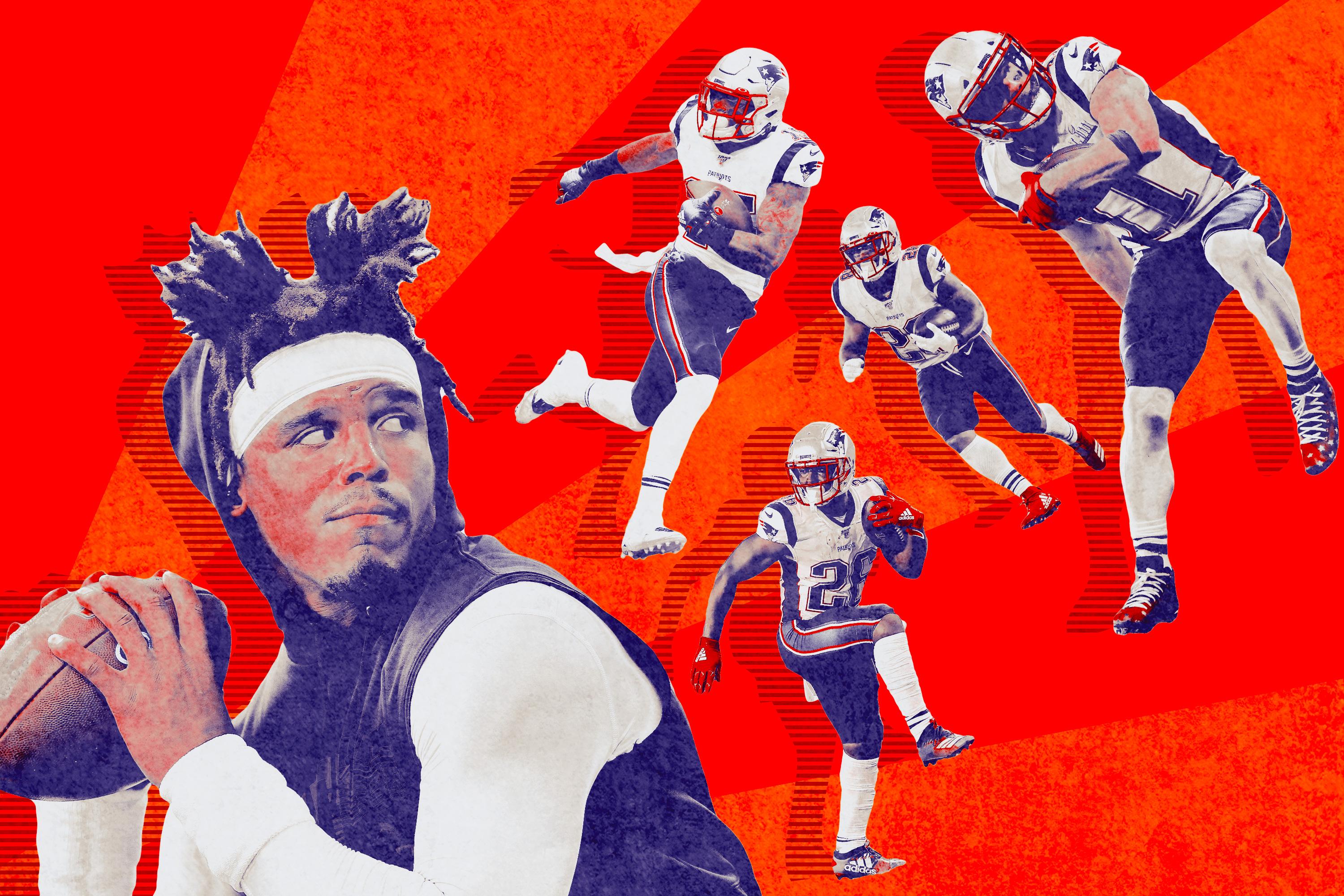
Cam Newton’s one-year deal in New England could bring about seismic shifts in both the AFC and in fantasy football. For the former, Newton restores the Patriots to their familiar place as divisional favorites and may even make them Super Bowl contenders. For the latter, Newton brings his unique skill set to what should be a fertile fantasy situation―where he’s got the chance to leap back onto the fantasy map and alter the outlook for a few of his new teammates.
Newton’s health, of course, remains the biggest X factor. If either his shoulder or foot injury—both of which have hindered him over the past two years—return, all bets are off. But by signing with the Patriots, the 31-year-old quarterback has quickly transformed from an undraftable fantasy afterthought to a potential mid- to late-round steal. He certainly won’t be throwing to the best group of receivers in the NFL (what else is new?), but he’ll be playing behind a strong offensive line while benefiting from the mad-scientist scheming of Bill Belichick and Josh McDaniels. That gives the former MVP a chance to resuscitate his career, shake up the fantasy quarterback hierarchy, and provide a boost for New England’s fantasy-relevant skill players. Let’s break down the fantasy implications of Newton’s deal with the Patriots.
Newton raises both New England’s overall offensive floor and its ceiling. Before Sunday, the Patriots had seemed intent on going into the 2020 season with either Jarrett Stidham or Brian Hoyer under center―and had nothing changed, I would have probably felt content in avoiding just about every New England player in my upcoming fantasy drafts. Pre-Newton, it was difficult to see the value in grabbing Julian Edelman, Sony Michel, or James White in the middle rounds (and I wasn’t even thinking about Stidham or Hoyer late). The further I get into a draft, the more I gravitate toward players in high-octane, high-scoring offenses that provide more scoring opportunities. With Stidham or Hoyer leading the charge, Edelman, White, or Michel might have provided an acceptable floor, but safe, low-ceiling players aren’t going to win you a championship.
Now that Newton’s in the mix, though, this offense loses that theoretical cap on its potential. I’m not expecting the veteran QB to magically turn this group into something resembling the 2007 Patriots offense, of course; he’s never been a highly efficient volume passer, and there’s no Randy Moss on this roster. But Newton’s prowess as both a thrower and runner does fundamentally change the dynamic for how teams must defend New England. That shift could be the key that unlocks the upside of a couple of the team’s fantasy-relevant players.
Let’s start with Newton himself. The former Panther missed all but two games in 2019, so let’s look back to the year prior, when he finished with a 24-to-13 touchdown-to-interception line in 14 games before an injury to his throwing shoulder prematurely ended his season. Newton made strides in his efficiency as a passer in 2018, as the team focused on quicker-hitting throws in the short and intermediate areas; he posted a career-best 67.9 completion rate with a 94.2 passer rating and a career-low 5.8 percent sack rate. His numbers are even more impressive if narrowed down to what he did before suffering the injury in a Week 10 loss to the Steelers. Through those nine games, Newton completed 68.5 percent of his throws with a 17-to-5 touchdown-to-interception ratio and a 101.2 passer rating. He was the fantasy QB6 in that stretch.
The Patriots are likely to focus on that quick-game stuff this year while mixing in some opportunities to push the ball downfield on play-action as well. Newton’s proficiency as a passer isn’t what makes him such an intriguing fantasy option, though, it’s the fantasy football scoring loophole that makes rushing yards worth 2.5 times as much as passing yards and rushing touchdowns worth 1.5 times as much as passing touchdowns that does. Newton’s dynamic rushing talent gives him a fighting chance to sneak into the QB1 group in 2020.
Newton won’t lead the quarterback position in rushing or set any new records like we saw Lamar Jackson do last year. But that doesn’t mean he’s suddenly going to be used like a pocket-passing statue, either. In 2018, the then-Panthers’ signal-caller finished as the overall QB8 in fantasy points per game, thanks in large part to the 101 carries, 488 yards, and four touchdowns he tallied on the ground. Those 101 carries ranked second at the quarterback spot, and helped Newton finish fourth in fantasy rushing points per game at the position.
Newton doesn’t even need to rack up 100-plus carries for the Patriots this year to crack the Konami Code with QB rushing stats; he just needs the right carries to make his leap. New England heavily relied on play-action from under center last year and could get Newton opportunities in the open field on naked bootlegs. And the team is likely to get their new quarterback involved as a rusher in high-leverage situations like third-and-short and near the goal line, the latter of which will be critical for fantasy production. They’d be silly not to, considering Newton’s been one of the most versatile and effective red-zone players of his generation. From 2011 to 2018, the dual-threat QB rushed for 55 red-zone touchdowns, more than any other player in the league—even running backs. He threw 117 touchdowns in that stretch too, which ranks 12th among all passers. Whether he’s throwing it or keeping it and running it himself, defenses rarely have a reliable answer for Newton around the goal line.
Newton’s talent as a runner should help open things up for the team’s run game as well. On read-option plays, he changes the math for the offense. Even when he’s handing the ball off, Newton acts as a de facto extra blocker for his offense, effectively holding the backside defender and keeping him out of the play. That variable could be a boon for the Patriots’ running backs and help provide more wide-open run lanes. Michel is first in line to benefit, at least between the 20-yard lines: The former first-rounder averaged just 3.7 yards per carry last year and often struggled to create for himself, finishing the year as the RB31 despite logging 247 carries, ninth most in the league. Michel has a chance to see heavy volume again in 2020, and I won’t be surprised if Newton’s presence helps boost the running back’s efficiency marks. I’m not quite ready to anoint Michel as a breakout fantasy option, though, considering Newton stands to vulture a good chunk of his red zone totes. I’m leaving Michel about where he was before the signing―as a low-end flex play with a reliable floor.
That said, I’m far more bullish on James White, who should move squarely back into RB2 territory again in 2020. The pass-catching specialist finished as the RB18 last year in PPR and should benefit from Newton’s veteran presence in the pocket. White’s not Christian McCaffrey, but Newton depended heavily on his running back as a pass-catching checkdown/swing-pass option in 2018, targeting McCaffrey 110 times in 14 starts. McCaffrey reeled in 94 of those passes for 768 yards and six scores. As ESPN’s Matthew Berry points out, 21.8 percent of Cam’s completions have gone to running backs since 2017 (compare that to Tom Brady’s 23.2 percent number in that same stat). We can assume Cam will keep hitting his outlet running back at a similar rate, and there’s no doubt that McDaniels and company will want to use White as a mismatch-creating option out of the backfield.
The move should help create more opportunity for the Patriots receivers, too. Prior to Newton’s arrival, I was pretty much out on Edelman, who’s being drafted on average at 76th overall. He’s no spring chicken at 34 years old, and it’s tough to account for the loss of all those years of chemistry and trust he built with Brady. That’s still true with Newton behind center, of course, but it’s a far safer bet that an established, proven veteran passer can stand in the pocket and connect with Edelman on a consistent basis, particularly the option routes he specializes in over the middle of the field. The veteran receiver finished as a WR1 last year in PPR formats (the WR7 overall), and while I’m projecting him closer to a WR3/Flex option this season, that’s still better than what I would’ve expected with Stidham under center.
Past Edelman, Mohamed Sanu and N’Keal Harry are the team’s two big wild cards. Sanu’s coming off a disappointing finish to the season in which he fought through a high-ankle sprain after being traded to New England. Sanu, who caught 26 passes for 207 yards and a touchdown in eight games for the Patriots last year, is nothing more than a late-round dart throw right now, but could emerge from the team’s tough-to-predict depth chart as one of Newton’s trusted targets. I’m a little higher on Harry, though, whom I’ll be grabbing in the last round of as many drafts as I can. Harry’s first season was derailed by an ankle injury, but the rookie flashed enough in limited action to portend a Year 2 breakout. Harry’s a physical, win-at-the-catch-point-type receiver, and Newton has never been afraid to throw it up and trust his receiver to come down with the ball. We saw that with both Kelvin Benjamin and Devin Funchess in Carolina.
At the tight end position, it’s anybody’s guess as to who will get major snaps. Matt LaCosse is the de facto starter, but don’t be surprised if rookie Devin Asiasi emerges as a viable target over the middle. Tight ends rarely produce fantasy-relevant numbers as rookies, but the Patriots may have no other choice but to rush the former UCLA Bruin into action in Year 1. Newton’s always shown an affinity for hitting big-bodied pass-catchers (like Greg Olsen) on vertical seam routes downfield, so there are worse ways to spend that final pick in your draft on a guy like Asiasi.
I’m not expecting Newton to turn back into the absolute game-wrecker whom we saw earlier in his career, and he’s nowhere near the same style of pocket-passer that Brady is, so it’s tough to predict the exact style and personality this Patriots offense will have in 2020. But Newton’s diverse skill set makes him well-suited to helm what’s always been one of the most nimble offenses in the NFL under both Belichick and McDaniels. It’s a good bet that the Patriots will have a plan to utilize Newton’s talents―and I think that will translate to better production—both on the field and in fantasy—than we’d have seen with any other quarterback on that roster.

